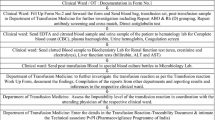Abstract
In India transmission of transfusion transmissible infections (TTI) has shown a relative decrease as a result of mandatory screening of donated blood for TTI’s. However, reducing the incidence of non infectious complications poses a major challenge, mainly due to the fact that a number of adverse reactions go unreported. Blood transfusion reaction, can be categorized based on the time interval between transfusion of blood products and the presentation of adverse reactions as acute i.e. those presenting during or within 24 h and as delayed i.e. those presenting anytime after 24 h. Transfusion reactions can further be classified as immune and non immune or infectious and non infectious based on the pathophysiology. In this retrospective study which was undertaken with an aim to determine the type and frequency of non infectious complications due to transfusion of blood and blood products recorded the incidence of febrile non hemolytic transfusion reactions (FNHTR) 51.40 %, allergic reactions 40.14 %, non immune hemolytic reactions 4.22 %, hypothermia 2.81 %, anaphylaxis 0.70 % and iron overload 0.70 %. FNHTR which was found to be the most common complication in this study can certainly be minimized, if not completely eliminated by adopting a policy of universal leucodepletion, the implementation of which solely depends on the financial and infrastructure resources available. This study also reiterates the importance of hemovigilance as a tool to improve the safety of blood transfusion.

Similar content being viewed by others
References
Gerald Sandler S (2015) Transfusion Reactions. http://emedicine.medscape.com/article/206885-overview. Accessed 11 January 2015
Singh B, Verma M, Verma K (2004) Markers for transfusion-associated hepatitis in north indian blood donors: prevalence and trends. Jpn J Infect Dis 57:49–51
Bisht A, Singh S, Marwaha N (2013) Hemovigilance program-India. Asian J Transfus Sci 7(1):73–74
Ramani KV, Mavalankar DV, Govil D (2009) Study of blood-transfusion services in Maharashtra and Gujarat States. India J Health Popul Nutr 27(2):259–270
Kumar P, Thapliyal R, Coshic P, Chatterjee K (2013) Retrospective evaluation of adverse transfusion reactions following blood product transfusion from a tertiary care hospital: a preliminary step towards hemovigilance. Asian J Transfus Sci 7(2):109–115
Bhattacharya P, Marwaha N, Dhawan HK, Roy P, Sharma RR (2011) Transfusion-related adverse events at the tertiary care center in North India: an institutional hemovigilance effort. Asian J Transfus Sci 5(2):164–170
Haemovigilance Programme of India National Institute of Biologicals & Indian Pharmacopoeia Commission Collaboration. http://nib.gov.in/haemovigilance1.html. Accessed 11 January 15
Taylor C, Navarrete C, Contreras M (2008) Immunological complications of blood transfusion. Transfus Alter Transfus Med 10(3):112–126
Pomper GJ (2009) Febrile, allergic, and nonimmune transfusion reactions. Principles of transfusion medicine, 4th edn. Blackwell Publishing Ltd, Oxford, pp 826–846
Addas-Carvalho M, Salles TS, Saad ST (2006) The association of cytokine gene polymorphisms with febrile non-hemolytic transfusion reaction in multitransfused patients. Transfus Med 16(3):184–191
Harsh K, Gupta PK, Mishra DK, Sarkar RS, Jaiprakash M (2006) Leucodepletion and blood products. Med J Armed Forces India 62(2):174–177
Norfolk DR, Williamson LM (1995) Leucodepletion of blood products by filtration. Blood 9(1):7–14
Sharma DC, Rai S, Gupta S, Jain B (2014) Universal leukoreduction decreases the incidence of febrile nonhemolytic transfusion reactions to cellular blood components: a 5 year study. Int Blood Res Rev 2(6):279–288
Fumiya H (2013) Current understanding of allergic transfusion reactions: incidence, pathogenesis, laboratory tests, prevention and treatment. Br J Haematol 160(4):434–444
Sandler SG, Vassallo RR (2011) Anaphylactic transfusion reactions. Transfusion 51:2265–2266
Volker K (2008) Reactions induced by platelet transfusions. Transfus Med Hemother 35(5):354–358
Hendrickson JE, Hillyer CD (2009) Noninfectious serious hazards of transfusion. Anesth Analg 108(3):759–769
Vamvakas EC, Blajchman MA (2009) Transfusion-related mortality: the ongoing risks of allogeneic blood transfusion and the available strategies for their prevention. Blood 113(15):3406–3417
de Vries RR, Faber JC, Strengers PF (2011) Haemovigilance: an effective tool for improving transfusion practice. Vox Sang 100(1):60–67
Author information
Authors and Affiliations
Corresponding author
Rights and permissions
About this article
Cite this article
Philip, J., Pawar, A., Chatterjee, T. et al. Non Infectious Complications Related to Blood Transfusion: An 11 year Retrospective Analysis in a Tertiary Care Hospital. Indian J Hematol Blood Transfus 32, 292–298 (2016). https://doi.org/10.1007/s12288-015-0565-7
Received:
Accepted:
Published:
Issue Date:
DOI: https://doi.org/10.1007/s12288-015-0565-7




